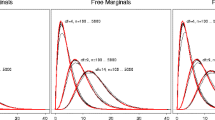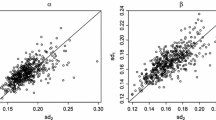Abstract
Rasch proposed an exact conditional inference approach to testing his model but never implemented it because it involves the calculation of a complicated probability. This paper furthers Rasch’s approach by (1) providing an efficient Monte Carlo methodology for accurately approximating the required probability and (2) illustrating the usefulness of Rasch’s approach for several important testing problems through simulation studies. Our Monte Carlo methodology is shown to compare favorably to other Monte Carlo methods proposed for this problem in two respects: it is considerably faster and it provides more reliable estimates of the Monte Carlo standard error.
Similar content being viewed by others
References
Andersen, E.B. (1973). Conditional inference for multiple-choice questionnaires. British Journal of Mathematical and Statistical Psychology 26, 31–44.
Andersen, E.B. (1980). Discrete Statistical Models with Social Science Applications. Amsterdam: North-Holland.
Andersen, E.B. (1995). What Georg Rasch would have thought about this book. In: G.H. Fischer, I.W. Molenaar (Eds.), Rasch Models: Their Foundations, Recent Developments and Applications. New York: Springer-Verlag.
Békéssy, A., Békéssy, P., Komlos, J. (1972). Asymptotic enumeration of regular matrices. Studia Scientiarum Mathematicarum Hungarica 7, 343–353.
Bender, E.A. (1974). The asymptotic number of nonnegative integer matrices with given row and column sums. Discrete Mathematics 10, 217–223.
Besag, J., Clifford, P. (1989). Generalized Monte-Carlo significance tests. Biometrika 76, 633–642.
Birch, M.W. (1964). The detection of partial association I: The 2×2 case. Journal of the Royal Statistical Society Series B 26, 313–324.
Birnbaum, A. (1968). Some latent trait models and their use in inferring an examinee’s ability. In: Lord FM, Novick MR (Eds) Statistical Theories of Mental Test Scores. Reading: Addison-Wesley.
Bishop, Y.M.M., Fienberg, S.E., Holland, P.W. (1975). Discrete Multivariate Analysis. Cambridge: MIT Press.
Chen, X.H., Dempster, A.P., Liu, J.S. (1994). Weighted finite population sampling to maximize entropy. Biometrika 81, 457–469.
Chen, Y. (2001). Sequential importance sampling with resampling: theory and applications. PhD dissertation, Department of Statistics, Stanford University.
Chen, Y., Diaconis, P., Holmes, S., Liu, J.S. (2005). Sequential Monte Carlo methods for statistical analysis of tables. Journal of the American Statistical Association 100, 109–120.
Coleman, J.S. (1957). Multidimensional scale analysis. American Journal of Sociology 63, 253–263.
Connor, E.F., Simberloff, D. (1979). The assembly of species communities: chance or competition. Ecology 60, 1132–1140.
Duncan, O.D. (1984). Rasch measurement: further examples and discussion. In: Turner, C.F., Martih, E. (Eds.), Surveying Subjective Phenomena (Volume 2). New York: Russell Sage Foundation.
Efron, B., Tibshirani, R.J. (1993). An Introduction to the Bootstrap. Boca Raton: Chapman & Hall.
Fischer, G.H. (1993). Notes on the Mantel–Haenszel procedure and another chi-squared test for the assessment of DIF. Methodika 7, 88–100.
Fischer, G.H. (1995). Some neglected problems in IRT. Psychometrika 60:449–487.
Fischer, G.H., Molenaar, I.W. (1995). Rasch Models: Foundations, Recent Developments, and Applications. New York, Springer-Verlag.
Glas, C.A.W. (1988). The derivation of some tests for the Rasch model from the multinomial distribution. Psychometrika 63, 525–546.
Glas, C.A.W., Verhelst, N.D. (1995). Testing the Rasch model. In: Fischer, G.H., Molenaar, I.W. (Eds.), Rasch Models: Their Foundations, Recent Developments and Applications. New York: Springer-Verlag.
Good, I.J., Crook, J. (1977). The enumeration of arrays and a generalization related to contingency tables. Discrete Mathematics 19, 23–65.
Gustafsson, J. (1980). Testing and obtaining fit of data to the Rasch model. British Journal of Mathematical and Statistical Psychology 33, 205–233.
Haberman, S.J. (1974). The Analysis of Frequency Data. Chicago: The University of Chicago Press.
Holland, P.W., Thayer, D.T. (1988). Differential item performance and the Mantel–Haenszel procedure. In: Wainer, H., Braun, H.I. (Eds.), Test Validity. Hillsdale: Erlbaum.
Kelderman, H. (1984). Loglinear Rasch model tests. Psychometrika 49, 223–245.
Kelderman, H. (1989). Item bias detection using loglinear IRT. Psychometrika 54, 681–697.
Kong, A., Liu, J.S., Wong, W.H. (1994). Sequential imputations and Bayesian missing data problems. Journal of the American Statistical Association 89, 278–288.
Lancaster, H.O. (1961). Significance tests in discrete distributions. Journal of the American Statistical Association 56, 223–234.
Lehmann, E.L. (1986). Testing Statistical Hypotheses, 2nd ed. New York: Wiley.
Liu, J.S. (2001). Monte Carlo Strategies in Scientific Computing. New York: Springer-Verlag
Mantel, N., Fleiss, J.L. (1980). Minimum expected cell size requirements for the Mantel–Haenszel one-degree-of-freedom chi square test and a related rapid procedure. American Journal of Epidemiology 112, 129–134.
Martin-Löf, P. (1973). Statistika Modeller. Anteckningar från seminarier läsåret 1969-1970 utarbetade av Rolf Sundberg. 2: a uppl.) (Statistical models. Notes from seminars 1969-1970 by Rolf Sundberg, 2nd ed). Institutet för Försä kringsmatematik och Matematisk Statistik vid Stockholms Universitet.
Mazor, K.M., Clauser, B.E., Hambleton, R.K. (1992). The effect of sample size on the functioning of the Mantel–Haenszel statistic. Educational and Psychological Measurement 52, 443–451.
Mengersen, K.L., Robert, C.P., Cuihenneuc-Joyaux, C. (1999). MCMC convergence diagnostics: A review. In: Bernando, J.M., Berger, J.O., Dawid, A.P., Smith, A.F.M. (Eds.), Bayesian Statistics (Volume 6). Oxford: Clarendon Press.
Molenaar, I.W. (1983). Some improved diagnostics for failure in the Rasch model. Psychometrika 48, 49–72.
Molenaar, I.W. (1995). Estimation of Item Parameters. In: Fischer, G.H., Molenaar, I.W. (Eds.), Rasch Models: Their Foundations, Recent Developments and Applications. New York: Springer-Verlag.
Neyman, J., Pearson, E.S. (1933). On the problem of the most efficient tests of statistical hypotheses. Philosophical Transcations of the Royal Society A 231, 289–337.
Orlando, M., Thissen, D. (2000). Likelihood-based item-fit indices for dichotomous item response theory models. Applied Psychological Measurement 24, 50–64.
Pashall, C.G., Miller, T.R. (1995). Exact versus asymptotic Mantel–Haenszel DIF statistics: a comparison of performance under small-sample conditions. Journal of Educational Measurement. 32, 302–316.
Ponocny, I. (2001). Nonparametric goodness-of-fit tests for the Rasch model. Psychometrika 66, 437–460.
Rao, A.R., Jana, R., Bandyopadhyay, S. (1996). A Markov chain Monte Carlo method for generating random (0,1) matrices with given marginals. Sankhya series A 58, 225–242.
Rasch, G. (1960). Probabilistic Models for Some Intelligence and Attainment Tests. Copenhagen: Danish Institute for Educational Research.
Rasch, G. (1966). An individualistic approach to item analysis. In: P.F. Lazarsfeld and N.W. Henry (Eds.), Readings Mathematical Social Science. Chicago: Science Research Associates.
Roberts, A., Stone, L. (1990). Island-sharing by archipelago species. Oecologia 83, 560–567.
Shepard, L.A., Camilli, G., Williams, D.M. (1985). Validity of approximation techniques for detecting item bias. Journal of Educational Measurement 22, 77–105.
Snijders, T.A.B. (1991). Enumeration and simulation methods for 0-1 matrices with given marginals. Psychometrika 56 (3), 397–417.
Stouffer, S.A., Toby, J. (1951). Role conflict and personality. American Journal of Sociology 56, 395–406.
Tatsuoka, K.K., Linn, R.L. (1983). Indices for detecting unusual patterns: links between two general approaches and potential applications. Applied Psychological Measurement 7, 81–96.
van den Wollenberg, A.L. (1982). Two new test statistics for the Rasch model. Psychometrika 47, 123–139.
Wright, B.D. (1977). Solving measurement problems with the Rasch model. Journal of Educational Measurement 14, 97–116.
Wright, B.D., Stone, M.H. (1979). Best Test Design. Chicago: Mesa Press.
Author information
Authors and Affiliations
Corresponding author
Additional information
This Research was supported in part by National Science Foundation grant DMS-0203762 and a University of Pennsylvania Research Foundation grant.
The authors are grateful to Don Burdick for helpful comments. In addition, the authors wish to thank the editor, the associate editor, and the referees for their helpful suggestions.
Rights and permissions
About this article
Cite this article
Chen, Y., Small, D. Exact tests for the rasch model via sequential importance sampling. Psychometrika 70, 11–30 (2005). https://doi.org/10.1007/s11336-003-1069-1
Published:
Issue Date:
DOI: https://doi.org/10.1007/s11336-003-1069-1




